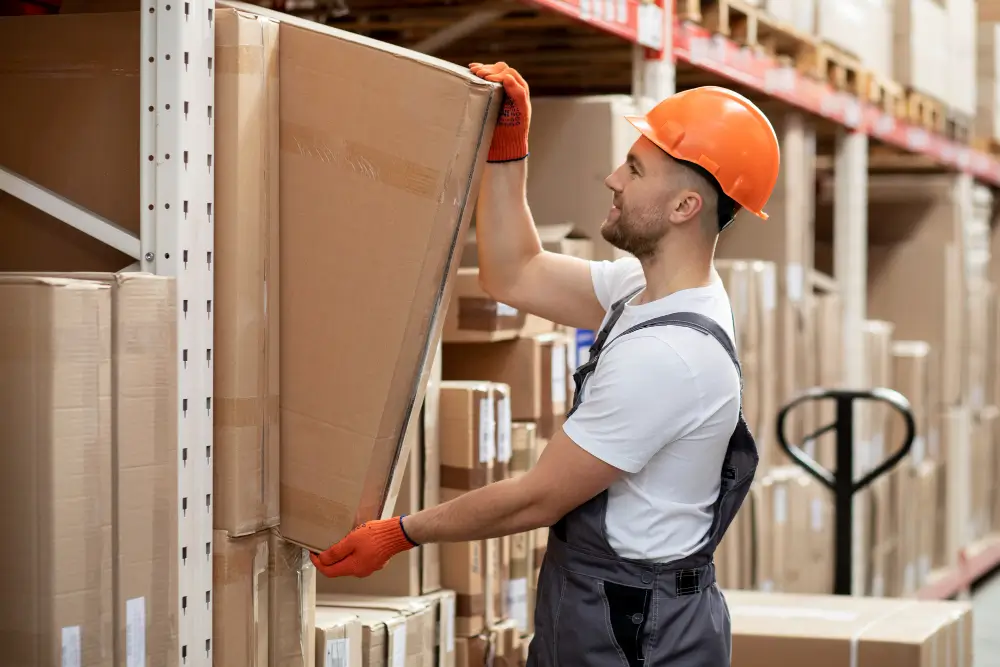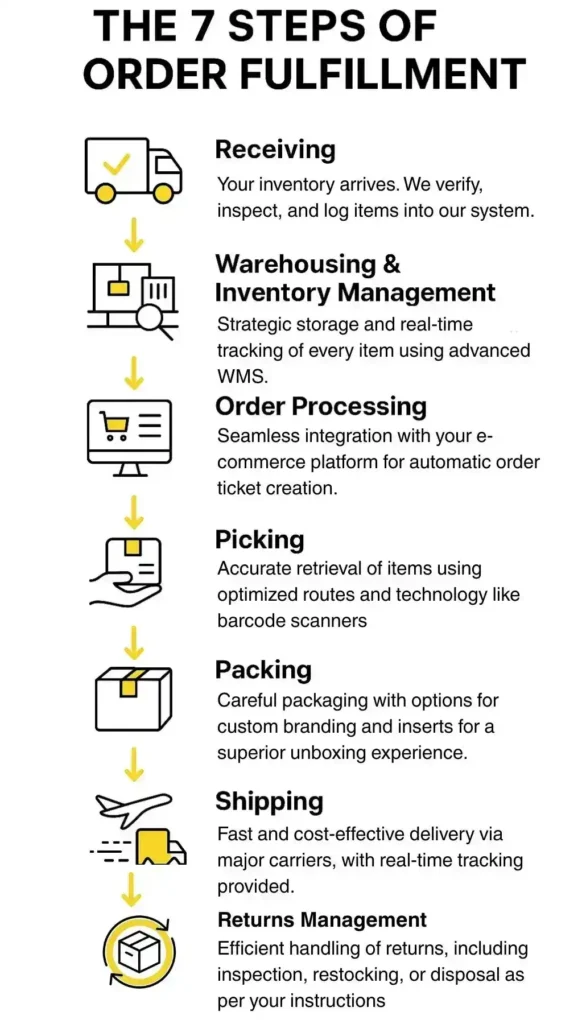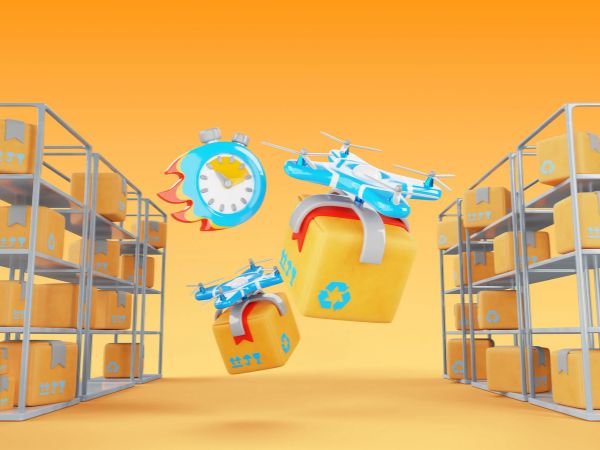Choosing a fulfillment service partner is one of the most significant decisions an e-commerce business owner will make. In a world where customer expectations for fast, free, and accurate shipping are the norm, your fulfillment strategy can be the single greatest determinant of your brand’s success or failure.
A well-chosen partner acts as a seamless extension of your business, handling the complex logistics while you focus on brand building, product development, and customer acquisition. A poor choice, however, can lead to costly errors, damaged reputation, and lost customers.
This comprehensive guide will walk you through everything you need to know about the fulfillment industry and provide a detailed checklist of what to look for when selecting a fulfillment service partner.
What is the Fulfillment Service? A Deeper Dive

At its core, a fulfillment service is a third-party logistics (3PL) provider that manages the entire post-purchase process for an e-commerce business. This begins the moment a customer clicks “buy” and ends when the product is in their hands. The term service fulfillment refers to the successful delivery of a service or product that meets the agreed-upon standards. A fulfillment company is the operational engine that makes this possible.
Think of it as outsourcing the entire back-end of your physical product sales. Rather than leasing a warehouse, hiring staff, buying equipment, and managing shipping carriers, you leverage the infrastructure and expertise of a specialist. This model allows businesses to be agile, scalable, and capital-efficient.
The Three Types of Order Fulfillment
Before you can choose a partner, it’s essential to understand the different models available:
- In-house Fulfillment: You handle everything yourself. This is common for startups with low order volumes, but quickly becomes a massive time and resource sink as you grow.
- Dropshipping: You sell a product, and a third-party supplier ships it directly to the customer. You never touch the inventory. This model is low-risk but offers limited control over quality, branding, and shipping times.
- Third-Party Fulfillment (3PL): This is the model we are focusing on. You send your inventory to a fulfillment company, and they handle all the logistics from there. It’s the most scalable solution for growing e-commerce brands.
The Seven Steps of the Order Fulfillment Process

Understanding the detailed steps of fulfillment is key to evaluating a partner’s capabilities. A top-tier provider should have optimized processes and robust technology at every stage.
- Receiving: This is the first step where your inventory arrives at the fulfillment center. The provider’s team unloads the shipment, verifies quantities against the packing list, inspects for any damage, and then enters the items into their inventory management system. An efficient receiving process is crucial to avoid delays and ensure inventory accuracy from the start.
- Warehousing and Inventory Management: Once received, your products are strategically placed in the warehouse. A good fulfillment partner uses a Warehouse Management System (WMS) to track every item’s exact location, from the moment it’s received to the moment it’s picked. They can optimize storage to minimize costs and retrieval time. Look for systems that offer real-time inventory visibility and help you set reorder points.
- Order Processing: The order journey begins. Your e-commerce store’s shopping cart (e.g., Shopify, WooCommerce, BigCommerce) is integrated with the fulfillment company’s WMS. When a customer places an order, the data is automatically transmitted and an order ticket is created. This integration is non-negotiable for efficiency and accuracy.
- Picking: A warehouse associate receives the order ticket, which often includes the most efficient path through the warehouse to locate all the items. Technology like barcode scanners and robotic systems are used to ensure the right product is picked, minimizing errors. This is a critical step; a high order picking accuracy rate is a key performance indicator (KPI) of a good partner.
- Packing: The picked items are taken to a packing station. Here, they are carefully packaged, sealed, and prepared for shipment. A quality partner will offer multiple packaging options, from standard boxes and poly mailers to branded and custom packaging, complete with inserts, promotional materials, or personalized notes. This is where your brand’s unboxing experience comes to life.
- Shipping: The packaged order is handed over to a shipping carrier. A fulfillment company leverages its volume to get discounted rates with major carriers (e.g., USPS, UPS, FedEx, DHL) and then selects the most cost-effective and fastest shipping method based on the destination and customer’s preference. They also provide tracking information to both you and your customer.
- Returns Management (Reverse Logistics): The process doesn’t end with delivery. A comprehensive fulfillment partner will handle returns, also known as reverse logistics. They receive the returned package, inspect the items, and either restock them or dispose of them based on your instructions. A smooth return process is as vital to customer satisfaction as a fast delivery.
What to Look for in a Fulfillment Service Partner
Now that you have a firm understanding of the landscape, here is the detailed checklist of what to evaluate in a potential fulfillment partner.

1. Technology and E-commerce Integration
This is the lifeblood of a modern fulfillment partnership. A fulfillment provider’s technology should be a strength, not a weakness.
- Seamless Integration: Does their system offer a native, pre-built integration with your e-commerce platform? This automates the flow of order data and inventory updates, preventing manual errors and saving countless hours.
- Robust WMS: The WMS is the brain of their operation. It should provide real-time visibility into your inventory levels across all their locations. You should be able to see exactly what you have in stock, where it is, and what’s in transit.
- Reporting and Analytics: Can you access a dashboard that shows you key metrics in real time? Look for reports on order accuracy, on-time shipping rates, shipping costs per order, and inventory turnover. Data-driven decision-making is essential.
- API Capabilities: For custom needs or larger operations, a robust API is a must. It allows you to build custom integrations and pull the data you need into your own systems.
2. Service Level Agreements (SLAs) and Performance Metrics
A partnership without clear, measurable goals is a recipe for disaster. A formal Service Level Agreement (SLA) is a contract that defines the performance standards a fulfillment partner promises to meet.
- Key Metrics to Demand:
- Order Accuracy Rate: The percentage of orders shipped with the correct items. A standard goal is 99.5% or higher.
- On-Time Shipping: The percentage of orders shipped within the agreed-upon timeframe (e.g., 24-48 hours).
- Dock-to-Stock Time: The time it takes for new inventory to be received and made available for sale. A good target is 24-72 hours.
- Return Processing Time: The speed at which returns are processed and the customer is notified.
- Remedies for Failure: What happens if they fail to meet a metric? A clear SLA should outline penalties or credits for errors, lost inventory, or missed deadlines.
3. Scalability, Flexibility, and Omnichannel Capability
Your business is going to grow, and your fulfillment partner needs to be able to grow with it.
- Handling Peak Seasons: Can they handle a sudden surge in orders during peak seasons like Black Friday or the holidays? Ask about their preparation, staffing plans, and historical performance during these periods.
- Multi-Channel & B2B Fulfillment: If you sell on multiple platforms (e.g., your website, Amazon, eBay) or plan to sell wholesale to big-box retailers, you’ll need a partner with omnichannel fulfillment expertise. This includes specific experience with B2B fulfillment, which has different requirements for bulk orders, palletized shipping, and retail compliance.
- Value-Added Services (VAS): Look for a partner who offers services that can enhance your business, such as kitting and bundling (combining multiple SKUs into a single product), custom packaging, subscription box fulfillment, and product assembly.
4. Geographic Location and Shipping Rates
The location of your fulfillment center is a strategic decision that directly impacts shipping speed and cost.
- Strategic Location: A partner with a strategically located warehouse (or multiple warehouses) can help you reach a large portion of your customer base within 1-2 days, a critical factor for competing with giants like Amazon.
- Shipping Carrier Relationships: Due to their massive shipping volume, fulfillment companies get significant discounts from major carriers. Ask them about their carrier relationships and how they pass those savings on to you. Be sure their pricing model is transparent, without hidden fees or surprise surcharges.
5. Cost Transparency and Pricing Models
While cost should not be the only factor, it’s a major one. A good partner will be completely transparent about their pricing structure.
- Common Costs to Consider:
- Onboarding/Setup Fee: A one-time fee to integrate your systems and set up your account.
- Receiving Fees: Charged for the time and labor to receive and process your inventory. Often per-hour or per-pallet.
- Storage Fees: Charged for the space your inventory occupies. Can be per-bin, per-shelf, per-pallet, or based on cubic footage.
- Pick & Pack Fees: The labor cost to retrieve and pack an order. Often a base fee per order plus a small fee for each additional item.
- Packaging Fees: Costs for boxes, mailers, tape, and void fill.
- Shipping Costs: The most significant and variable cost.
- Additional Fees: Ask about hidden costs like returns processing, kitting, or special handling fees for fragile or oversized items.
6. Reputation and Customer Support
A fulfillment partnership is a relationship built on trust.
- Reputation and References: Ask for references from other companies in your industry. Talk to their existing clients to understand their experience with communication, problem-solving, and reliability.
- Dedicated Account Manager: A single point of contact can make a huge difference, especially during peak season or when issues arise. You don’t want to get lost in an anonymous customer service ticket system.
- Communication Style: How do they communicate during the sales process? Are they responsive, knowledgeable, and transparent? This is a good indicator of how they will operate as a partner.
A Final Note: The Difference Between Supply Chain and Fulfillment
To wrap up, remember the key distinctions. The supply chain is the end-to-end network of all entities involved in delivering a product, from raw materials to final customer. Fulfillment is a crucial, but single, process within that larger chain. By choosing the right fulfillment service partner, you are optimizing one of the most vital links in your supply chain, paving the way for sustainable growth and a world-class customer experience.
If you are looking for a reliable fulfillment service partner to help you navigate these complex decisions and streamline your logistics, visit our blog at Logistics770.com for more insights and to explore how we can help your business thrive.
